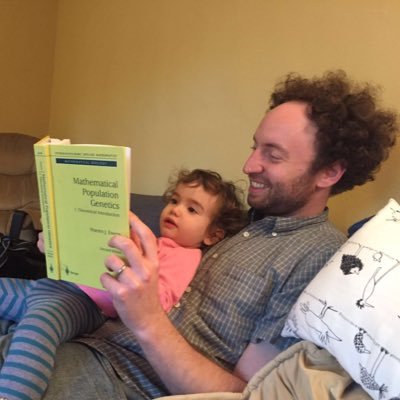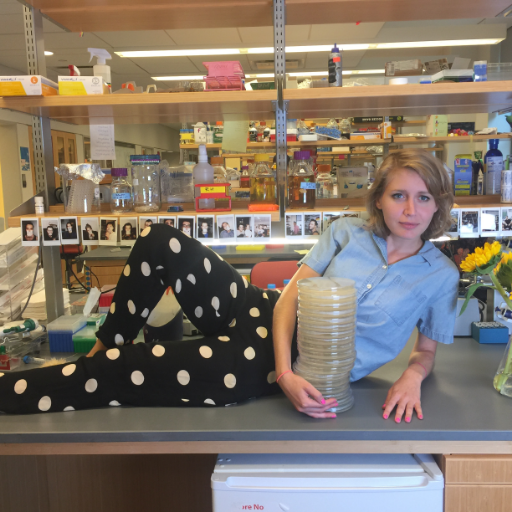
Franz Baumdicker
@fbaumdicker
Followers
367
Following
1K
Media
11
Statuses
215
Mathematical and Computational Population Genetics Microbial Evolution | Machine Learning in PopGen | CRISPR-Cas | Pan-genomes | HGT 🦠 ➔ 🧬 ➔ 💻 ➔ 🤔
University of Tübingen
Joined November 2018
Join us as a #PostDoc @uni_tue for 2 years! Work on large-scale genealogical data, develop #machinelearning methods, make an impact by decoding local ancestries (ARGs), and improve #popgen and medical studies in collab. with @Boehringer. More info here: https://t.co/aPWRf6cA6t
0
8
16
If you are interested in microbial #pangenomes, join us @eseb2025 in Barcelona with Jesse Shapiro and Anna Dewar. Only two days left to submit an abstract! https://t.co/8csIeisXMo
0
6
7
please spread the word about this theoretical population biology workshop in chicago in june! should be really fun
nitmb.org
0
37
86
Is it “winner-takes all” when the simplest living things compete? Check out my fresh publication on phage coexistence in Science and a thread below🧵
science.org
Bacteriophages are the most abundant and phylogenetically diverse biological entities on Earth, yet the ecological mechanisms that sustain this extraordinary diversity remain unclear. In this study,...
3
64
160
The life of cells, recorded https://t.co/sPv0y0BpIW. We dive into the opportunities of DNA recording for understanding single cell dynamics. Fantastic collaboration with the @JShendure, @ElowitzLab, Gagnon, and Schier labs.
0
9
26
AstraZeneca's Centre for Genomics Research is hiring! Check it out if you are interested in leading an exceptional team of scientists who apply innovative machine learning approaches to large scale genomic and multi-omic data for drug discovery. https://t.co/sJoM9GVaOk
lnkd.in
This link will take you to a page that’s not on LinkedIn
0
7
33
It is crucial to use reconstructed arrays to see these deletion patterns, as the position of spacers shifts toward the trailer end over time. I will post more details about our reconstruction tool SpacerPlacer later. But you can find the tool here:
1
0
2
Finally, across multiple CRISPR-Cas types and genera, we found no significant difference in deletion rates or lengths, suggesting that spacer deletions are likely not modulated by Cas proteins.
1
0
1
CRISPR spacer deletions may be more common at the leader due to a) mutations of the last repeat b) recently acquired spacers lacking a long-term benefit c) benefits of changing the spacers at the first most expressed positions d) (reconstruction errors) e) all of the above
1
0
1
The spacer deletions at the very first and last positions of CRISPR arrays deviate from a symmetric boundary effect. The reconstructed deletion rate is higher at the first positions compared to the losses at the last positions. This might have multiple reasons ...
1
0
1
Besides the boundary effect, we observe no change of deletion frequencies along arrays. They evolve surely non-neutrally, but our results hint at either weak selection pressures to delete specific spacers or an equally strong selection along the array to maintain spacers. But,...
1
0
1
Consistent with this mechanism, we observe a “boundary effect”: Spacer deletions are less frequent near the leader and trailer ends of the array, potentially due to fewer neighboring repeats for alignment, while the middle of the array sees the most deletions.
1
0
2
Interestingly, besides the loss of a single spacer, deletions occur often in blocks, involving an average of 2.7 spacers per event. This block deletion aligns with theories of replication slippage, where nearby repeats misalign, leading to multiple spacer deletions.
1
0
2
Spacer deletions in CRISPR arrays follow fascinating patterns. Using our tool SpacerPlacer, we found that deletion events are 374x more frequent than single-nucleotide mutations, making immunity loss by spacer loss much more likely than by mutations.
1
0
2
CRISPR arrays store "immune memories" of past invaders as spacers. But these memories aren’t permanent— frequent spacer deletions reshape the array. We investigated the spacer deletion dynamics with our new reconstruction tool and learned a lot... 🧵 https://t.co/0pHz1MR412
2
6
19
🎉 tskit 0.6.0 is released! 🎉 Thanks to our wonderful contributors, this is a bumper release. Read all about it at: https://t.co/NaTr9gHSMV
0
7
8
This @PslQlife Winter School is gonna be A M A Z I N G ! Come to Paris and let's chat about Polygenic Adaptation, Quantitative Genetics, and Pop Gen!
“Polygenic Adaptation from Quantitative Genetics to Population Genomics” 👉🏼 Deadline: January 8, 2025 👉🏼 Detailed description and application https://t.co/42ENqQK7pE
@NedaBarghi @FrancoisMallard @KatrinaMcGuiga3 @Lufpa @EvolOdonata @jsztepanacz @pdevillemereuil @henriqueteoton2
0
2
5
🧬🧬 𝙉𝙚𝙬 𝙋𝙧𝙚𝙥𝙧𝙞𝙣𝙩!!🧬🧬 Latest collab with the amazing Ming Li & Yue Feng labs! How do phages bypass multi-layered defenses in bacteria? Spoiler: with equally complex anti-defenses!! 🧵👇
biorxiv.org
In prokaryotes, arrayed CRISPR RNAs (crRNAs) guide Cas proteins to destroy phage DNA/RNA, while solitary crRNA-like RNAs (crlRNAs) program Cas proteins for auto-regulation or to control abortive...
3
29
119












